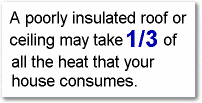|
| Insulation is the material which is added in
an effort to slow down the transfer of heat which in turn, is intended to make a house
more comfortable and energy efficient. A house can
admit unwanted heat in the summer and loose precious heat in the winter, through many
different avenues. For instance, an ordinary single-glazed window (a window with
only one pane) may allow more than 20 times more heat to escape than the wall around it,
even though the wall area is far larger than the window, while a double-glazed window (a
window with two panes) can cut that same heat loss by more than one-half. |
| Poorly sealed cracks around the foundation,
sill, chimney, and siding can account for as much as 10% of your heating costs. A ¼ inch
gap under a typical outside door is equivalent to a 3 inch square hole in your wall. If
your house has many such cracks and gaps, they can add up to a hole the size of a picture
window! |

|
| It is not an uncommon occurrence
for me to
inspect an older home where the insulation hasn't been upgraded since the house was built.
I find many homeowners are surprised at the increased energy savings and interior
comfort level they experience, when they finally do upgrade. Often, with a relatively
minimal expenditure in money and effort, a homeowner can make the small upgrades himself.
The return on investment here can be significant. Unless
you are comfortable with your skills, it may be a good idea to leave bigger jobs like
completely re-insulating and ventilating an entire attic, to a professional. While it
may cost you more to hire one, you can be sure the job is done properly.
When upgrading the attic insulation in a house, one should
always check into how well vented the attic is. Attic insulation and ventilation
go hand-in-hand. You may need to make upgrades here, as well. See "Proper Attic Ventilation" for reference. |
The following list ranks some commonly found heat
robbers from the highest to the lowest, based on their typical long-range
payback vs. initial money and effort expended:
Weather stripping around
doors and windows
- Caulking cracks
- Insulating windows & doors
- Insulating attics
- Insulating floor or basement
- Insulating walls
|
The following map shows the
insulation (heating) zones for the U.S., based upon seasonally adjusted temperatures.
This map is used in conjunction with the insulation chart below, to determine the
recommended R-value in a given location.
|
|
